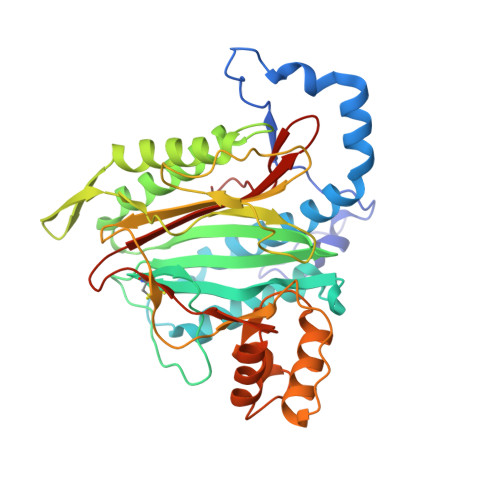Spiroepoxytriazoles Are Fumagillin-like Irreversible Inhibitors of MetAP2 with Potent Cellular Activity.
Morgen, M., Jost, C., Malz, M., Janowski, R., Niessing, D., Klein, C.D., Gunkel, N., Miller, A.K.(2016) ACS Chem Biol 11: 1001-1011
- PubMed: 26686773
- DOI: https://doi.org/10.1021/acschembio.5b00755
- Primary Citation of Related Structures:
5CLS, 5D6E, 5D6F - PubMed Abstract:
Methionine aminopeptidases (MetAPs) are responsible for the cotranslational cleavage of initiator methionines from nascent proteins. The MetAP2 subtype is up-regulated in many cancers, and selective inhibition of MetAP2 suppresses both vascularization and growth of tumors in animal models. The natural product fumagillin is a selective and potent irreversible inhibitor of MetAP2, and semisynthetic derivatives of fumagillin have shown promise in clinical studies for the treatment of cancer, and, more recently, for obesity. Further development of fumagillin derivatives has been complicated, however, by their generally poor pharmacokinetics. In an attempt to overcome these limitations, we developed an easily diversifiable synthesis of a novel class of MetAP2 inhibitors that were designed to mimic fumagillin's molecular scaffold but have improved pharmacological profiles. These substances were found to be potent and selective inhibitors of MetAP2, as demonstrated in biochemical enzymatic assays against three MetAP isoforms. Inhibitors with the same relative and absolute stereoconfiguration as fumagillin displayed significantly higher activity than their diastereomeric and enantiomeric isomers. X-ray crystallographic analysis revealed that the inhibitors covalently modify His231 in the MetAP2 active site via ring-opening of a spiroepoxide. Biochemically active substances inhibited the growth of endothelial cells and a MetAP2-sensitive cancer cell line, while closely related inactive isomers had little effect on the proliferation of either cell type. These effects correlated with altered N-terminal processing of the protein 14-3-3-γ. Finally, selected substances were found to have improved stabilities in mouse plasma and microsomes relative to the clinically investigated fumagillin derivative beloranib.
Organizational Affiliation:
Cancer Drug Development Group, German Cancer Research Center (DKFZ) , Im Neunheimer Feld 280, D-69120 Heidelberg, Germany.

















